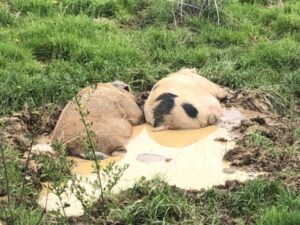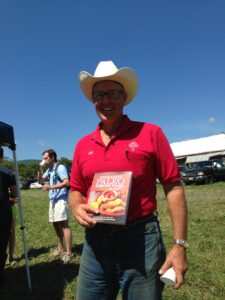I’ve been waiting to write this post for a while now. Seemed fitting to wait until I had the chance to visit White Oak Pastures this past weekend and participate in the Regenerative Summit hosted by the Center for Agricultural Resilience. The term “Regenerative Farming” is getting thrown
around more and more these days. Considering that one of the primary tenets of Farrow Skincare is our reliance on regenerative farming practices to produce our SmartLard™, it seemed appropriate to offer up more detail.
WHAT IS REGENERATIVE FARMING?
We would define regenerative farming/agriculture as production of food & fiber utilizing natural processes that build soil. Let’s break that down a bit…
Food and Fiber Production
Y’all know we gotta eat right? In addition to the occasional meal, it’s nice to be able to clothe ourselves, sleep on comfy bed linens, and occasionally use a rope to help climb things. Whether you’re more on a plant-based or carnivorous diet, the components that make up your diet must be grown and tended to.

Utilizing Natural Processes
In nature, there is seasonality. Animals move and express their natural characteristics: cows graze and mow, pigs root and rub, birds sanitize and eat the bugs. Nature doesn’t have thousands of acres of the same plant or animal. Multiple species of plants and animals occupy the land in a natural system. It is incumbent upon us to leverage the sunshine, rainfall, and unique capabilities of animals to ultimately build a more resilient and healthy ecology on our landscape.
Building Soil
Nature has a simple formula for building soil. Aggressive animal impact and grazing is followed by birds sanitizing and finally long periods of rest on the land. This is precisely how the deep soils of corn belt in America were built. Fundamentally, it cannot be regenerative agriculture unless
WHY REGENERATIVE FARMING?
Modern farming systems and perpetual reliance/use of chemical fertilizers, herbicides, and fungicides have degraded and eroded our topsoil around the world. According to many leading experts, we only have 40-60 harvests of topsoil left…you heard that correctly…
According to many experts, due to the constant degradation and loss of our most precious global asset (soil), we only have approximately 60 crop harvests left.
Some estimates peg the yearly loss of soil globally at around 24 billion tons—that’s roughly 3.4 tons of soil lost per year PER PERSON on the planet. Folks, if we run out of topsoil, the game is over.
Fortunately, you have the incredible work of organizations like The Savory Institute. Allan Savory has shown repeatedly that his Holistic Land Management approach can reverse desertification and build back our precious soils.
Fortunately, we have farmers like Joel Salatin of Polyface Farms and Will Harris at White Oak Pastures employing the principles espoused by the Savory Institute. There are Savory Institute hubs popping up all over the place…I get my breakfast sausage from Hickory Nut Gap—as Savory
Hub in North Carolina.

HOW TO BE A REGENERATIVE FARMER!
Fortunately, we have many examples to draw from when it comes to the “How To” of being a regenerative farmer. Polyface Farms, White Oak Pastures, Hickory Nut Gap and Joyce Farms are shining examples of optimal farming practices that build soil and have little/no reliance on chemicals or fertilizers. Farrow is currently sourcing its fat from Joyce Farms…love their fat! So, the short answer to “how” is to follow the leader. I’ve mentioned several great leaders in the space already. There are a few big points I’d like to drive home.
Regenerative farming cannot be complete without the presence of animals. Taking that one step further, I would say that some form of ruminant species should exist in your model.
Reduce and/or eliminate chemicals, fertilizers, herbicides, fungicides, and tillage. These toxic inputs aren’t doing you or the land any favors.
More animals and fewer synthetic chemicals. Nature’s model works very well and the good Lord has gifted us with the responsibility of tending to the land and animals. Final point—for those of you reading this that aren’t interested in becoming a regenerative farmer…please consider finding a few and supporting them with your money and support.
